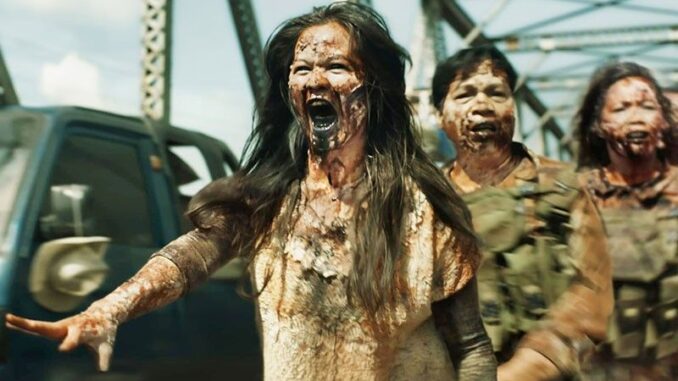
MANILA, Philippines — “Why are the zombies still talking?” and other burning questions about Netflix Philippines’ “Outside” are finally answered by director Carlo Ledesma.
How did the movie create a unique identity for the Pinoy zombie — one that both pays homage to the genre’s global roots while at the same time incorporating fresh elements that reflect cultural context?
In an interview with The STAR, the Filipino-Australian filmmaker broke down inspirations and motivations behind how he reimagined zombies — or the “dead ones,” as he put it — in his psychological thriller about a family fighting for survival during a violent outbreak.
“Outside” doesn’t over-explain the origins of its zombies. But the director gave an easter egg for those paying close attention, particularly to the scene where Sid’s character, Francis, tested the water that originated from the deep well.
Direk Carlo admitted that it was a subtle hint that the cause of the zombie outbreak could be waterborne.
“Maybe in future films we can explain the origin,” he told this writer, adding that he’s leaving it up to the audience to decide.
“What is important for me is for the audience to realize, wait a minute, why are they talking or why are they saying words?”
In the film, there were “dead ones” repeatedly saying sorry or mouthing off church prayers. It turns out these were the last words or last fragments of their memories while tragically fighting off the infection.
Carlo’s vision was to portray them as more complex creatures clinging, in a way, to remnants of their former selves.
“Because usually, in most zombie films, they’re not talking anymore, mas monsters na sila. When I was writing the film, I found it important that I still wanted the audience to feel sorry for each of the zombies that you see. These creatures still have a glimmer of humanity in them,” he explained.
“When you watch the film, whatever word they are saying is the last thing that they said before they were bitten or yung last memory nila. Which is why the different characters are saying different things. It’s like their last memory while still trying to escape and still trying to fight for the fact na human sila. But because the infection is so strong, it pushes it back.”
As for the physical appearance of “Outside” zombies, direk Carlo wanted to channel his own fears. For one, his trypophobia — an aversion to clusters of small holes — had a role in creating the monsters.
“I have slight trypophobia, which is why if you noticed, most of the zombies have holes in them. I wanted to create that feeling of scare in the way they look,” he said.
Another striking feature is their eyes, which are colored black as a result of hemorrhaging.
“I wanted their eyes to be black because I had imagined that once they would get infected, mag-hemorrhage yung mata nila and therefore, would turn black, making them a bit blind.”
Playing around this concept of partial blindness, he said they have to rely on a heightened sense of smell and hearing.
“They do a lot of smelling and a lot of hearing because they can’t really see too well. So those were the main things I wanted to show, aside from the speaking, of course.”
When asked about the movement of his zombies, direk Carlo based it on a specific logic.
The former “Gameplan” host and producer, whose favorite zombie flicks are Danny Boyle’s “28 Days Later” (2002), Nicholas Meyer’s “The Day After” (1983) and the Viggo Mortensen starrer “The Road (2009), also took into consideration the levels of speed and agility.
In Hollywood and even Korean movies and dramas, zombies are either shuffling slowly or sprinting.
“What I wanted to do here, sa zombie acting workshop namin, sabi ko kung ano yung edad niyo, that’s how fast you are. Kasi nagtatanong sila, ‘Am I a slow zombie or am I a running zombie?’ Sabi ko, whatever your age is as a person and how you move as a regular person, that’s how I want you to move when you’re infected,” he recalled.
“So, sometimes, you’ll see an old zombie moving slowly, but then sometimes you’ll see a younger zombie running (in the film). Because for me, the logic there is that it’s what they were when they were bitten, so it would make sense na ganun pa rin yung physical characteristics nila.
“In terms of the way they look, they are uniformed. But the way they move, I said, it’s very dependent on how old you are.”
All these would somehow suggest that the zombies of “Outside” have lingering humanity, like a reminder that these people once lived, thought and felt, that audiences could still feel pity or empathy for these creatures despite their monstrous states.
Even with this attention to detail and character-driven design, there’s a bigger theme or message that the director wanted to send to his audiences.
“Probably, they’ll watch it kasi mahilig sila sa zombie films. But when they watch it, I hope they realize that this is really a movie about the monsters in all of us, and that it’s okay that we’re not perfect people. I want audiences to realize that it’s okay to have conflict within themselves, but what’s important is that they have the desire to become better people.”


Be the first to comment